Study on Field Test of Deformation and Stability Control Technology for Shallow Unsymmetrical Loading Section of Super-Large-Span Tunnel Portal
Abstract
1. Introduction
2. Engineering Background
2.1. Overview of Tunnel
2.2. Overview of the Shallow Unsymmetrical Loading Section
2.3. Construction Scheme
3. Field Test
3.1. Field Monitoring Scheme
3.2. Monitoring Results
4. Numerical Simulation
4.1. Numerical Model Establishment
4.2. Model Parameters
5. Results
5.1. Different Excavation Sequence
5.2. Different Drift Ratio
6. Optimization Benefit Analysis
6.1. Efficiency and Economic Benefits Analysis
6.2. Stability Control Measures
- Strengthen the advance support. The tunnel section adopts a Φ108 mm hot rolled steel pipe roof umbrella system with a thickness of 6 mm; the length of the pipe roof umbrella system is 30 m, the ring spacing is 40 cm, and the lap length is 3 m. After entering the tunnel, with the increase in the buried depth, the double-layer grouting pipe is adopted, with lengths of 3 m and 4.5 m, respectively, and the longitudinal spacing is 1.8 m and 3 m, respectively.
- Improve the initial support stiffness. Add a feet-lock anchor pipe at the arch frame of each drift bench and temporary steel frame joint. The external insertion angle should be 20~30°, and I20b I-steel temporary horizontal support can be installed if necessary.
- Apply bolt and surrounding rock grouting. Adopt a hollow grouting bolt, with a length of 5 m, and spacing of 1.0 m × 0.6 m, and the grouting strength is not lower than M20.
- Control the length of the benches. The excavation length of the drift benches on both sides should be controlled at 3~5 m, and the drifts on both sides should not be less than 15 m.
- Optimize the construction sequence. Super-large-span tunnels have a flat structure, leading to more complex structural deformation and forces compared to other tunnel types. In contrast to the research findings of Ding et al. [28], the simulation results found that the excavation method of the shallow side first and then the deep side for super-large-span tunnels is more favorable for controlling structural deformations. The study suggests that when super-large-span tunnels are constructed using the double-side-wall drift method to traverse shallow buried unsymmetrical sections, the construction sequence of excavating the shallow side first, then excavating the deep side, and finally excavating the middle drift is recommended.
- Optimize the proportion of the drifts on both sides. The ratio of drifts on both sides of the super-large-span tunnel not only significantly affects the structural forces but also plays a crucial role in construction efficiency and economic benefits. Based on comprehensive analysis results, it is recommended to use a ratio of approximately 0.3 for on-site construction.
7. Conclusions
- (1)
- The arch settlement and horizontal convergence of the monitoring section mainly experience three stages: rapid growth, slow deformation, and stabilization. The deformation lasts a long time and finally reaches a relatively stable state. The deformation of each part is less than the reserved deformation; the tunnel deformation is the largest on the left, followed by the smallest on the right; and temporary support has a great impact on the initial support structure. The removal of the temporary support makes the deformation of the initial support quickly enter into a stable state, which mainly affects the resharing of the vertical load.
- (2)
- With the shallow-side-first excavation scheme, the arch settlement and plastic zone of the surrounding rock are smaller than the deep-side-first excavation scheme, while the horizontal convergence has no obvious difference, so the shallow-side-first excavation scheme is slightly better than the deep-side-first excavation scheme; with the increase in the ratio of drifts, the arch settlement of the various drifts and the horizontal convergence show a tendency to increase, and the scope of the plastic zone also gradually increases, with the initial support structure stress exhibiting a pattern of decreasing followed by an increase as the drift ratio increases. The structure reaches its most stable stress state at around 0.3.
- (3)
- According to the field test results of tunnel deformation and the numerical simulation results of the construction scheme, control measures such as strengthening the advance support, improving the stiffness of the initial support, adopting bolt and grouting of surrounding rock, controlling the length of the benches, and optimizing the construction sequence and the proportion of the drifts on both sides are proposed.
- (4)
- The scope of this study is focused on construction optimization, but it is important to note that when dealing with shallow buried unsymmetrical strata, design parameters like flatness and unsymmetrical degree of super-large-span tunnels play a significant role in structural stability. Future research should consider delving deeper into tunnel section and support structure design.
Author Contributions
Funding
Institutional Review Board Statement
Informed Consent Statement
Data Availability Statement
Acknowledgments
Conflicts of Interest
References
- Liu, W.W.; Chen, J.X.; Chen, L.J.; Luo, Y.B.; Shang, Q.C.; Zhang, L.X.; Gao, S.K.; Jia, H.Y. A Rational Construction Method and Deformation Control System of Tunnelling in Extremely Soft and Fractured Chlorite Schist Medium. Tunn. Undergr. Space Technol. 2024, 143, 105472. [Google Scholar] [CrossRef]
- Liu, W.W.; Chen, J.X.; Luo, Y.B.; Chen, L.J.; Zhang, L.X.; He, C.L.; Shi, Z.; Xu, Z.L.; Zhu, H.Y.; Hu, T.T.; et al. Long-term Stress Monitoring and In-Service Durability Evaluation of A Large-Span Tunnel in Squeezing Rock. Tunn. Undergr. Space Technol. 2022, 127, 104611. [Google Scholar] [CrossRef]
- Luo, Y.B.; Zhou, S.; Chen, J.X.; Liu, W.W.; Chen, L.J.; Li, Y.; Wu, Y.F. Mechanical Calculation Model and Research on Construction Mechanical Behavior of Middle Diaphragm in Upper Bench CD Method for Super-large Span tunnel. China J. Highw. Transp. 2020, 33, 235–248. [Google Scholar]
- Luo, Y.B.; Dong, F.F.; Wang, C.W.; Chen, J.X.; Zhu, T.T.; Zhang, L.X.; Liu, W.W. A Surrounding Rock Pressure Calculation Method for Super-Large-Span Highway Tunnels Considering Sequential Excavation. Chin. J. Rock Mech. Eng. 2022, 41, 1637–1646. [Google Scholar]
- Liu, X.J.; Zhang, Y.X. Analysis of Reasonable Excavation Sequence and Stress Characteristics of Portal Section of Shallow Tunnel with Unsymmetrical Loadings. Chin. J. Rock Mech. Eng. 2011, 30, 3066–3073. [Google Scholar]
- Chen, Y.; Luo, Y.B.; Gao, J.M.; Gao, S.C.; Jiao, Y.Z. Application of Double-layer Initial Support in Super-large-span Highway Tunnel. Sci. Technol. Eng. 2020, 20, 10486–10491. [Google Scholar]
- Zhang, J.R.; Wu, J.; Yan, C.W.; Gou, X.M.; Ye, L.; Feng, J.M. Construction Technology of Super-large Section of Highway Tunnels with Four or More Lanes in China. China J. Highw. Transp. 2020, 33, 14–31. [Google Scholar]
- Wang, W.F.; Mei, Z. Study of Application of Bench Method to Shallow-buried Asymmetrically-pressured Railway Tunnel of Super-large Cross-section. Tunn. Constr. 2017, 37, 1578–1584. [Google Scholar]
- Zhou, B.S. Optimizing CRD Construction Techniques for a Super-Shallow Bored Tunnel. Mod. Tunn. Technol. 2018, 55, 186–190. [Google Scholar]
- Luo, Y.B.; Chen, J.X. Monitoring and Analysis of the Deformation of the Middle Wall During the Construction of a Shallow Soil Tunnel by the CRD method. Mod. Tunn. Technol. 2011, 48, 105–109. [Google Scholar]
- Lei, M.F.; Peng, L.M.; Shi, C.H.; Wang, L.C.; Liu, Z.C. Model research on failure mechanism and lining stress characteristics of shallow buried tunnel under unsymmetrical pressure. J. Cent. S. Univ. Sci. Technol. 2013, 44, 3316–3325. [Google Scholar]
- Luo, J.W.; Zhang, D.L.; Sun, Z.Y.; Fang, Q.; Liu, D.P.; Xu, T.; Li, R. Numerical modelling and field monitoring study on large-span tunnelling using pretensioned bolt–cable combined support system. Tunn. Undergr. Space Technol. 2023, 132, 104911. [Google Scholar] [CrossRef]
- Al Hallak, R.; Garnier, J.; Leca, E. Experimental study of the stability of a tunnel face reinforced by bolts. In Proceedings of the Geotechnical Aspect of Underground Construction in Soft Ground, Tokyo, Japan, 19–21 July 1999. [Google Scholar]
- Lyu, C.; Zeng, Z.Q. Upper bound limit analysis of unsymmetrical progressive collapse of shallow tunnels in inclined rock stratum. Comput. Geotech. 2019, 116, 103199. [Google Scholar] [CrossRef]
- Zhao, Y.G.; Shao, S.J.; Han, C.L. Simulation on Different Excavation Construction of the Shallow-Buried Tunnel under the uneven Rock Pressure. Rock Soil Mech. 2009, 30, 509–513. [Google Scholar]
- Zhang, L.Q.; Gao, D.; Yang, H.; Mu, B.L.; Zhang, L.J.; Xu, Y.M. Study on Influence Scope of Shallow tunnel with unsymmetrical loadings Plastic Zone by Surface Dip and Buried Depth. J. Hebei Inst. Archit. Civ. Eng. 2016, 34, 14–18. [Google Scholar]
- Liu, Z.Q. Research on Deformation Monitoring Method and Deformation Law of Shallowly Buried Tunnels with Bias-pressure. Value Eng. 2019, 38, 179–180. [Google Scholar]
- Chen, Y.; Lin, C.M.; Huang, J.S.; Huang, Z.B.; Fu, X. The surrounding rock deformation laws of shallow-buried biased super-large cross-section tunnel excavated via CRD method. J. Zhengzhou Univ. Light Ind. Nat. Sci. 2013, 28, 76–79. [Google Scholar]
- Shi, Y.Z.; Li, J.F.; Li, W.Y.; Zhou, X.Q. Construction Mechanics of Tunnel with Super-Large Cross-Section and Its Dynamic Stability. J. Shanghai Jiao Tong Univ. 2015, 49, 1023–1029. [Google Scholar]
- Zhang, T.; Nie, L.; Zhang, M.; Dao, S.L.; Xu, Y.; Du, C.; Rui, X.J.; He, Y.Y. The Unsymmetrical Coefficient of Unsymmetrical-Loaded Tunnel Based on Field Monitoring and Numerical Simulation. Symmetry 2020, 12, 1793. [Google Scholar] [CrossRef]
- Lei, M.F.; Peng, L.M.; Shi, C.H. Model test to investigate the failure mechanisms and lining stress characteristics of shallow buried tunnels under unsymmetrical loading. Tunn. Undergr. Space Technol. 2015, 46, 64–75. [Google Scholar] [CrossRef]
- Lei, M.F.; Lin, D.Y.; Yang, W.C.; Shi, C.H.; Peng, L.M.; Huang, J. Model test to investigate failure mechanism and loading characteristics of shallow-bias tunnels with small clear distance. J. Cent. S. Univ. 2016, 23, 3312–3321. [Google Scholar] [CrossRef]
- Lei, M.F.; Peng, L.M.; Shi, C.H.; Xie, Y.J.; Tan, L.X. Upper bound analytical solution for surrounding rock pressure of shallow unsymmetrical loading tunnels. J. Cent. S. Univ. 2015, 22, 2339–2347. [Google Scholar] [CrossRef]
- Wang, K.Z.; Xiong, Y.; Li, S.; Zhou, X.; Li, Z.K. Deformation Characteristics Analysis of Temporary Support in Unsymmetrical Loading Tunnel Excavation under Composite Support. Symmetry 2023, 15, 830. [Google Scholar] [CrossRef]
- Wang, X.Y.; Tan, Z.S.; Liu, Q.L.; Zheng, W.H. Calculation Method for Determining the Wall Displacement and Primary Support Bearing Capacity of Tunnels. Appl. Sci. 2023, 13, 7296. [Google Scholar] [CrossRef]
- Zhu, Z.G.; Qiao, C.S.; Gao, B.B. Analysis of construction optimization and supporting structure under load of shallow multi-arch tunnel under unsymmetrical pressure. Rock Soil Mech. 2008, 154, 2747–2752. [Google Scholar]
- Mou, Z.H.; Yan, T.; Tian, M.J.; Zhang, J.X. Research on the construction method and reasonable excavation sequence of shallow tunnel with unsymmetrical loadings adjacent to changing roadbed slope. China Civ. Eng. J. 2017, 50, 203–208. [Google Scholar]
- Ding, Z.D.; Wang, W.W.; Wen, J.C.; Ji, X.F. A Study on Construction Sequence of Shallow Buried Bias Tunnel Considering Excavation Stress Path. J. Kunming Univ. Sci. Technol. Nat. Sci. 2020, 45, 140–148. [Google Scholar]
- Liu, Y.X.; Jiang, S.P.; Zhao, S.Y. Optimizing Analysis for Construction Schemes of Shallow Multi-Arch Loess Tunnel. Chin. J. Undergr. Space Eng. 2005, 1, 944–947. [Google Scholar]
- Zhang, Y.L.; Fu, X.K.; Liu, H.L.; Zheng, Y.Y. Study on the reasonable excavation sequence of shallow-embedded bias tunnels with small clear distance. J. Railw. Sci. Eng. 2013, 10, 57–63. [Google Scholar]
- Qu, H.F. Study on Load Mode of Road Tunnel with Extra-large Cross-Section and Low Flat-Ratio and Its Application. Ph.D. Thesis, Tongji University, Shanghai, China, 2007. [Google Scholar]
- Wang, J.X.; Cao, A.S.; Wu, Z.; Sun, Z.P.; Lin, X.; Sun, L.; Liu, X.T.; Li, H.B.Q.; Sun, Y.W. Numerical Simulation of Ultra-Shallow Buried Large-Span Double-Arch Tunnel Excavated under an Expressway. Appl. Sci. 2021, 12, 39. [Google Scholar] [CrossRef]
- JTG 3370.1-2018; Specifications for Design of Highway Tunnels Section 1 Civil Engineering. China Communications Press: Beijing, China, 2018.
- Zou, X.; Jiang, Y.S. Effect of grout on mechanical properties of soil-body. In Proceedings of the 4th China Academic Conference on Rock Anchorage and Grouting, Shanghai, China, 27–30 May 2007. [Google Scholar]

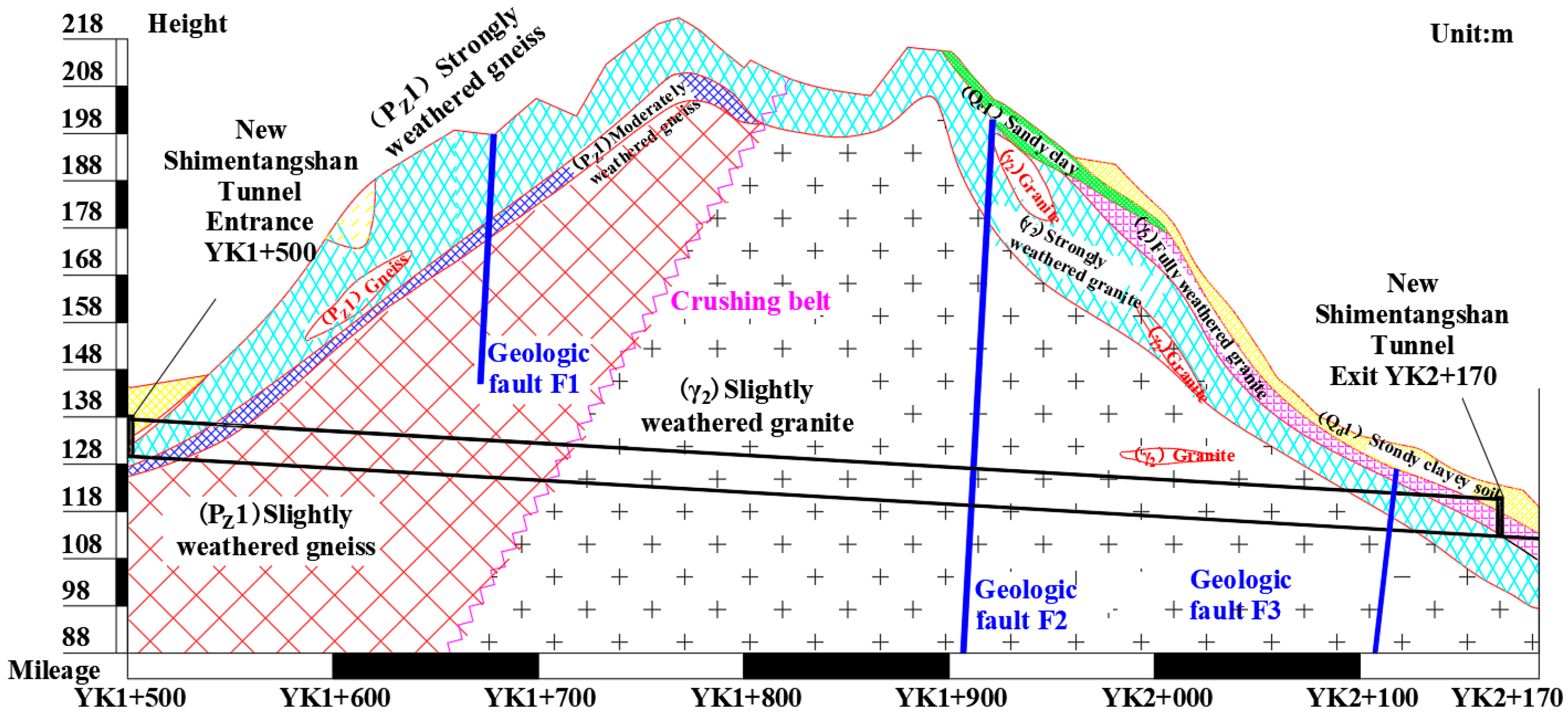


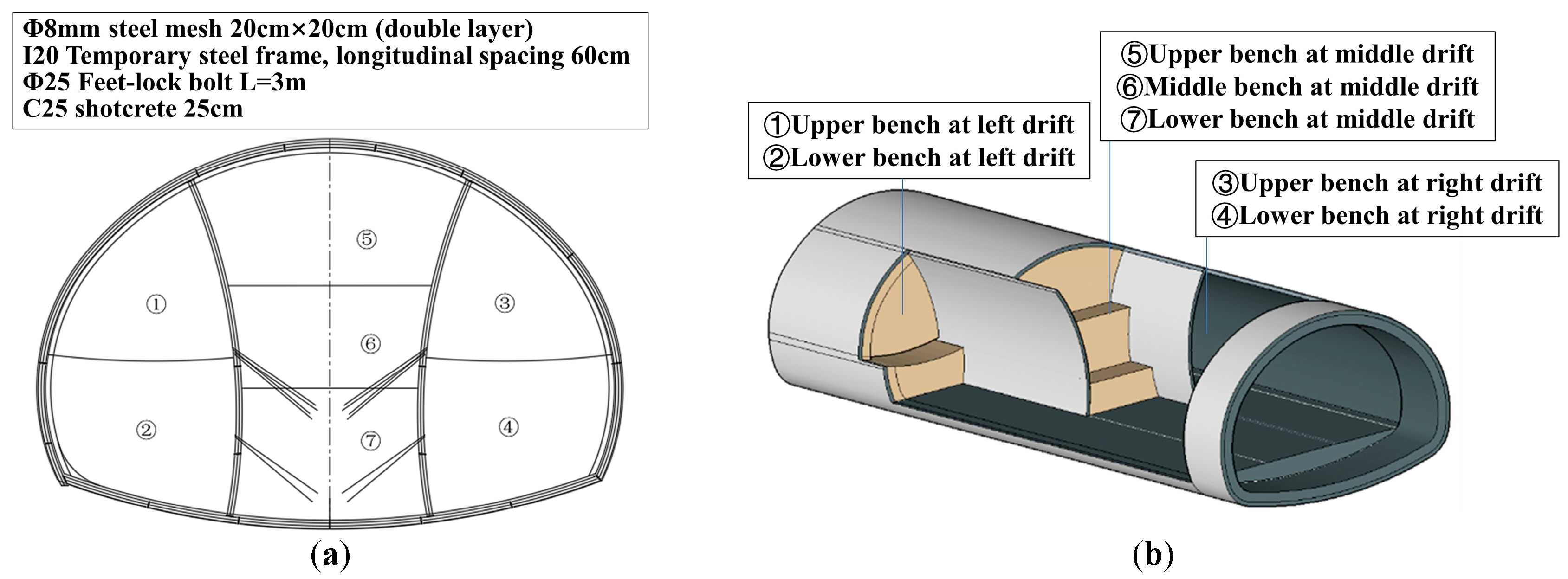
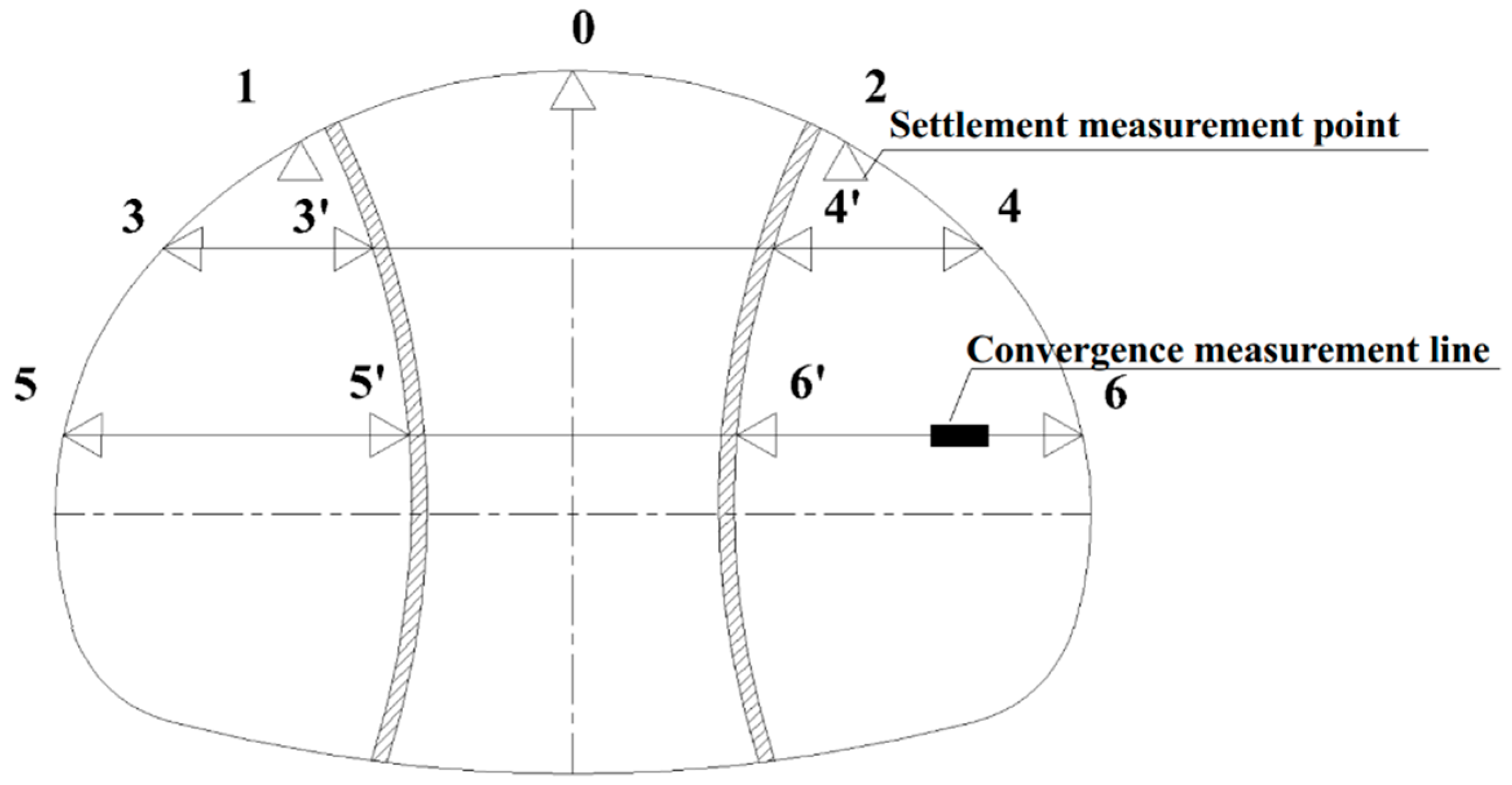



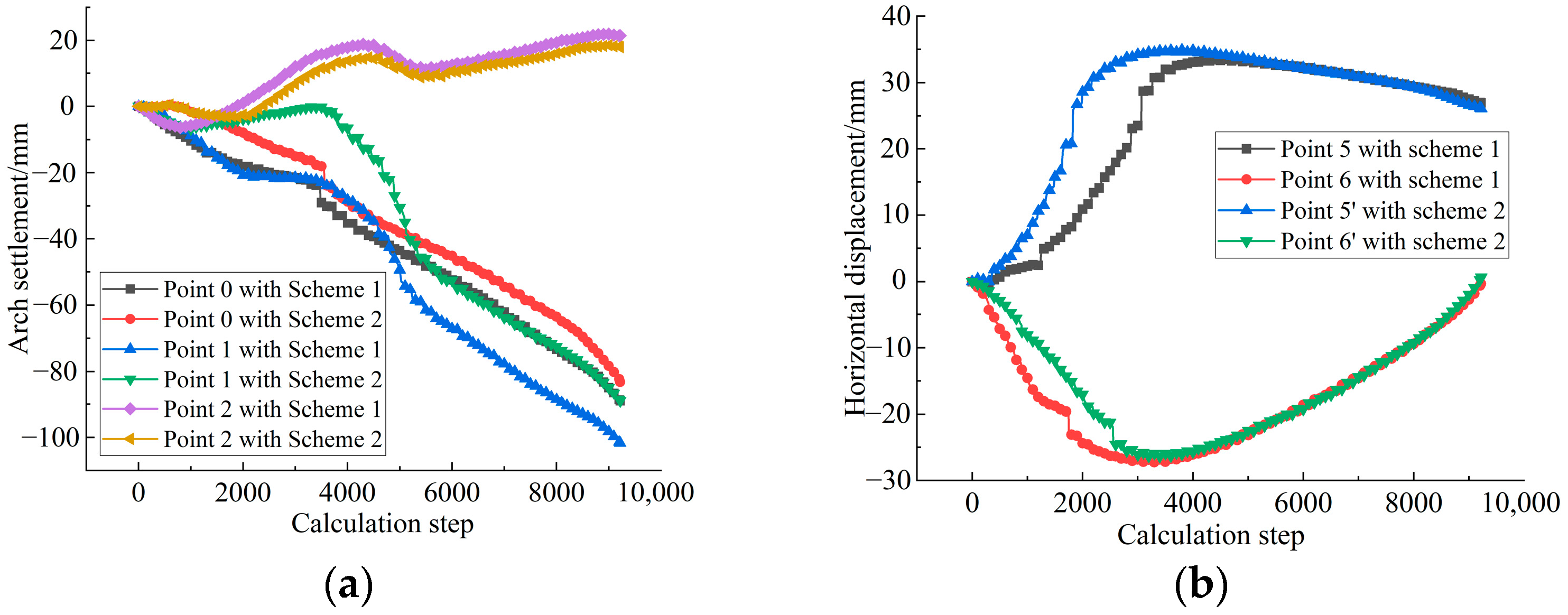
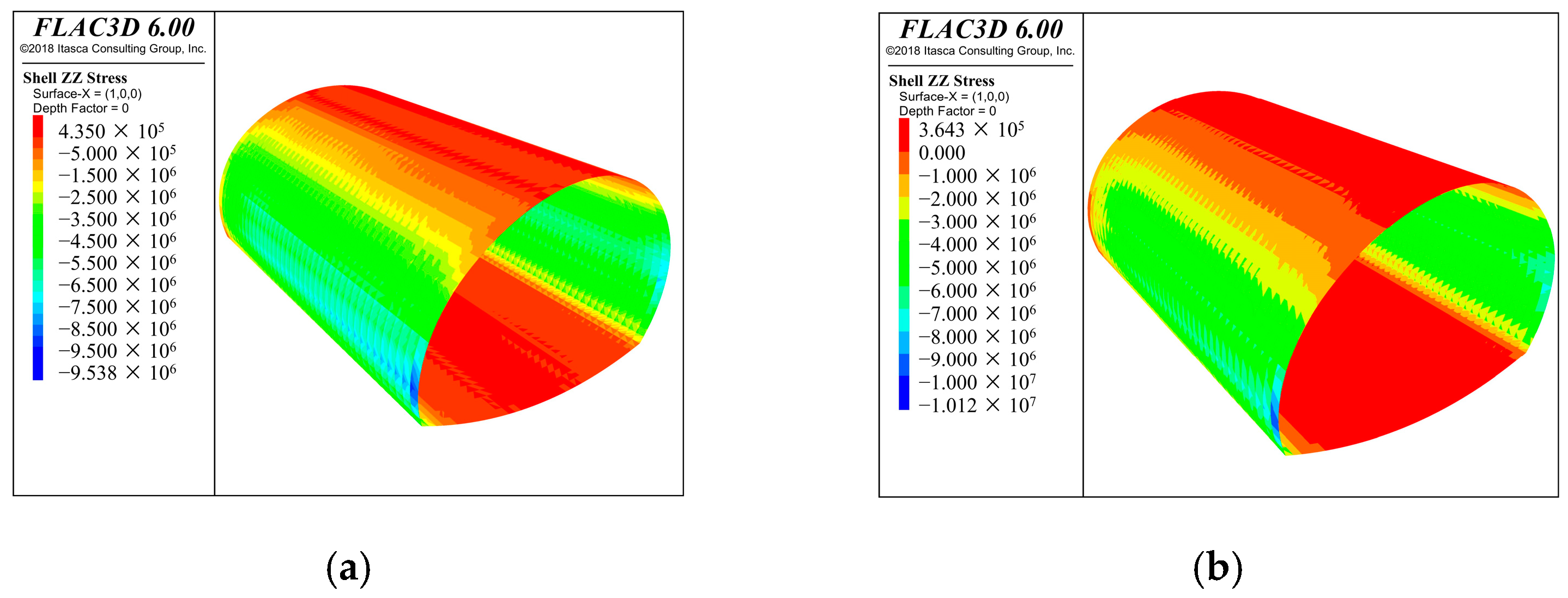
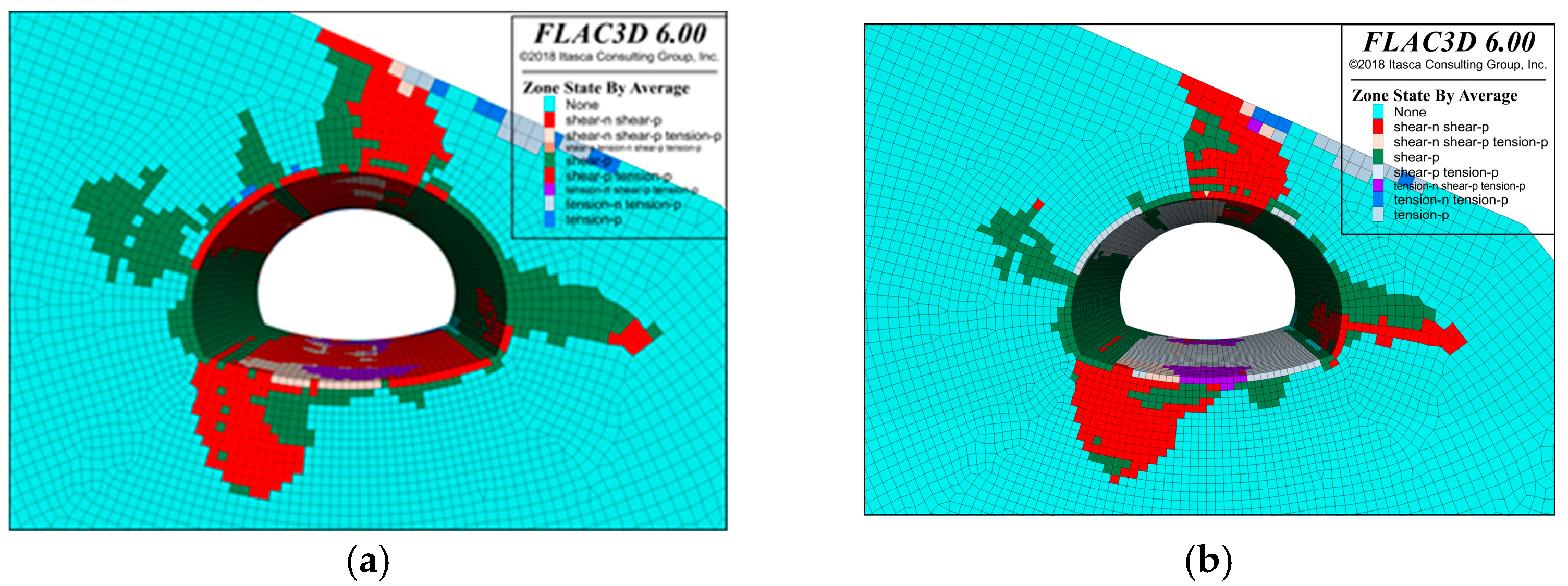
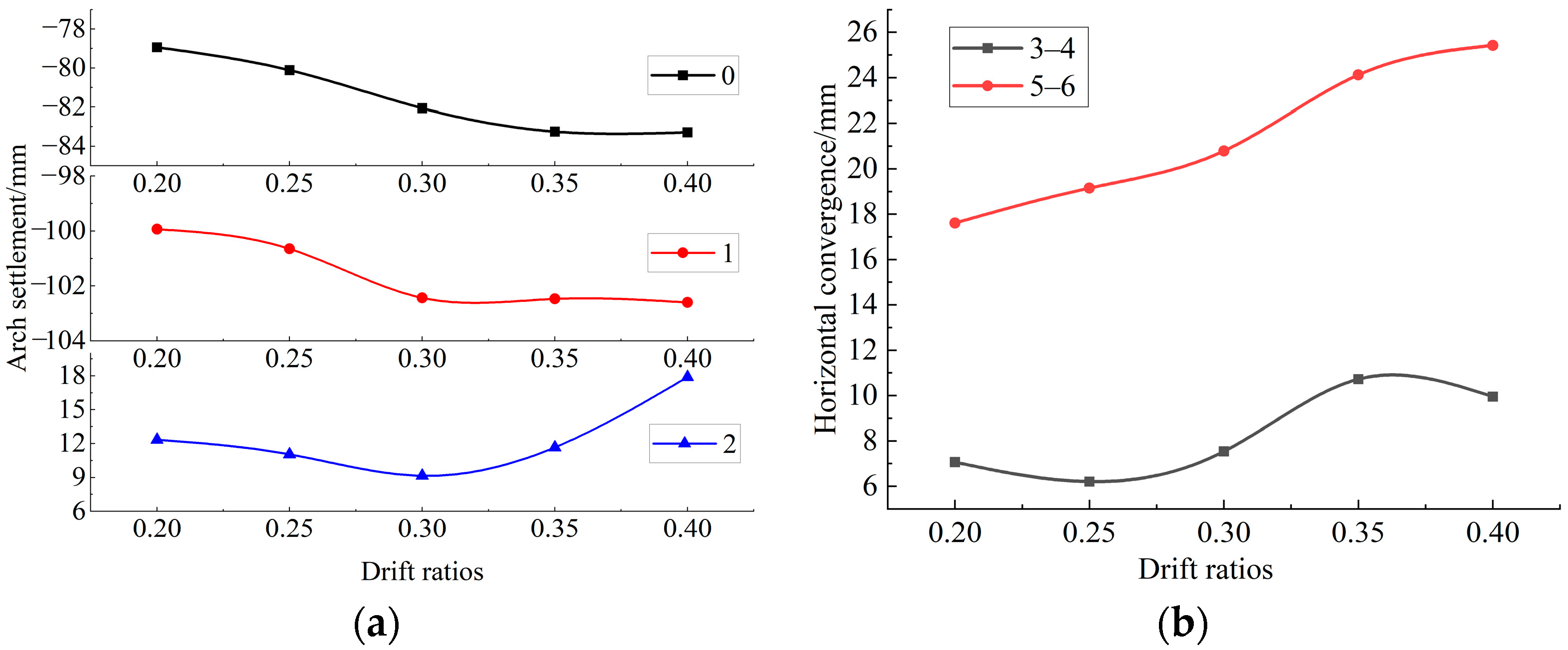
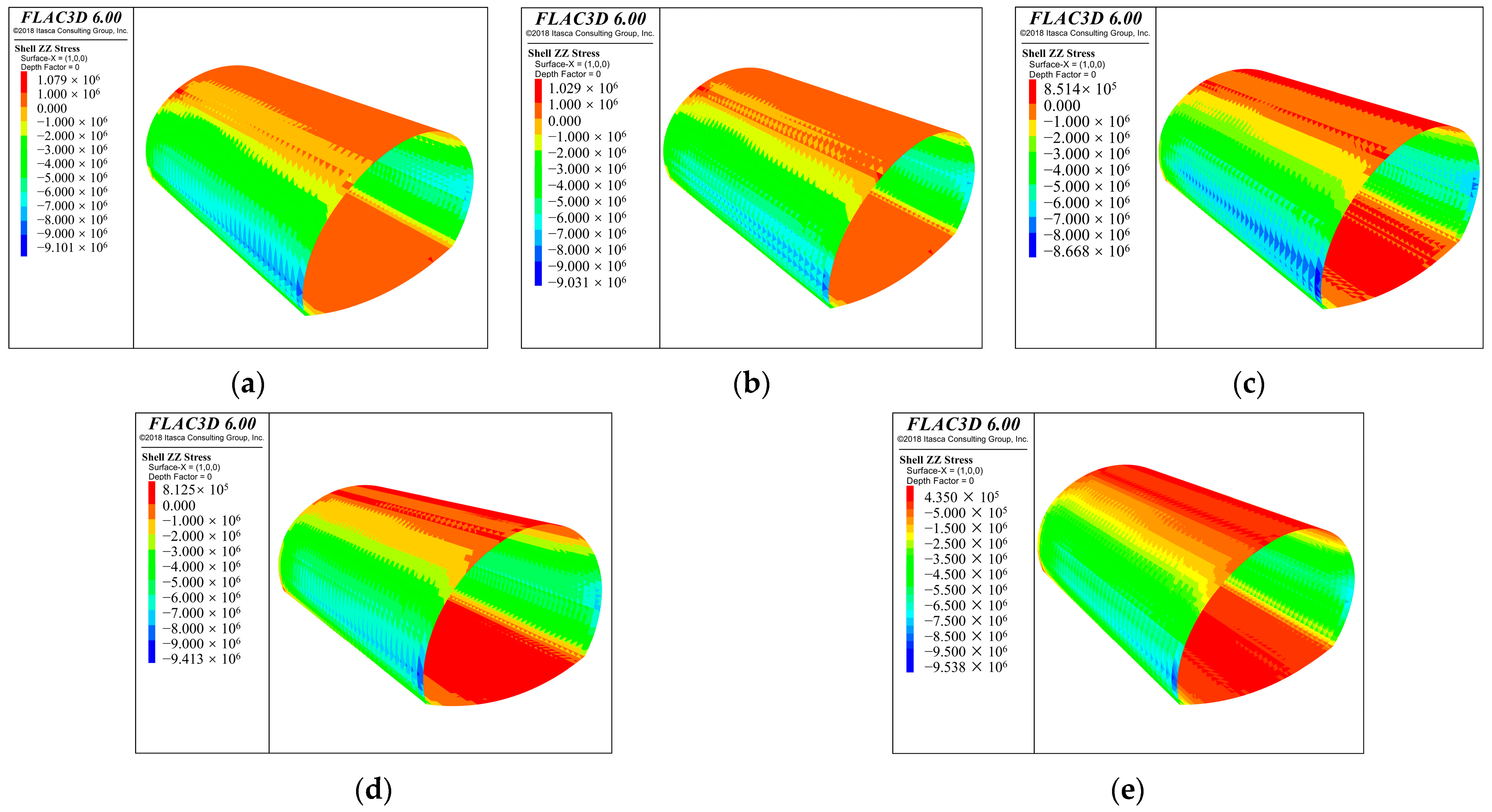
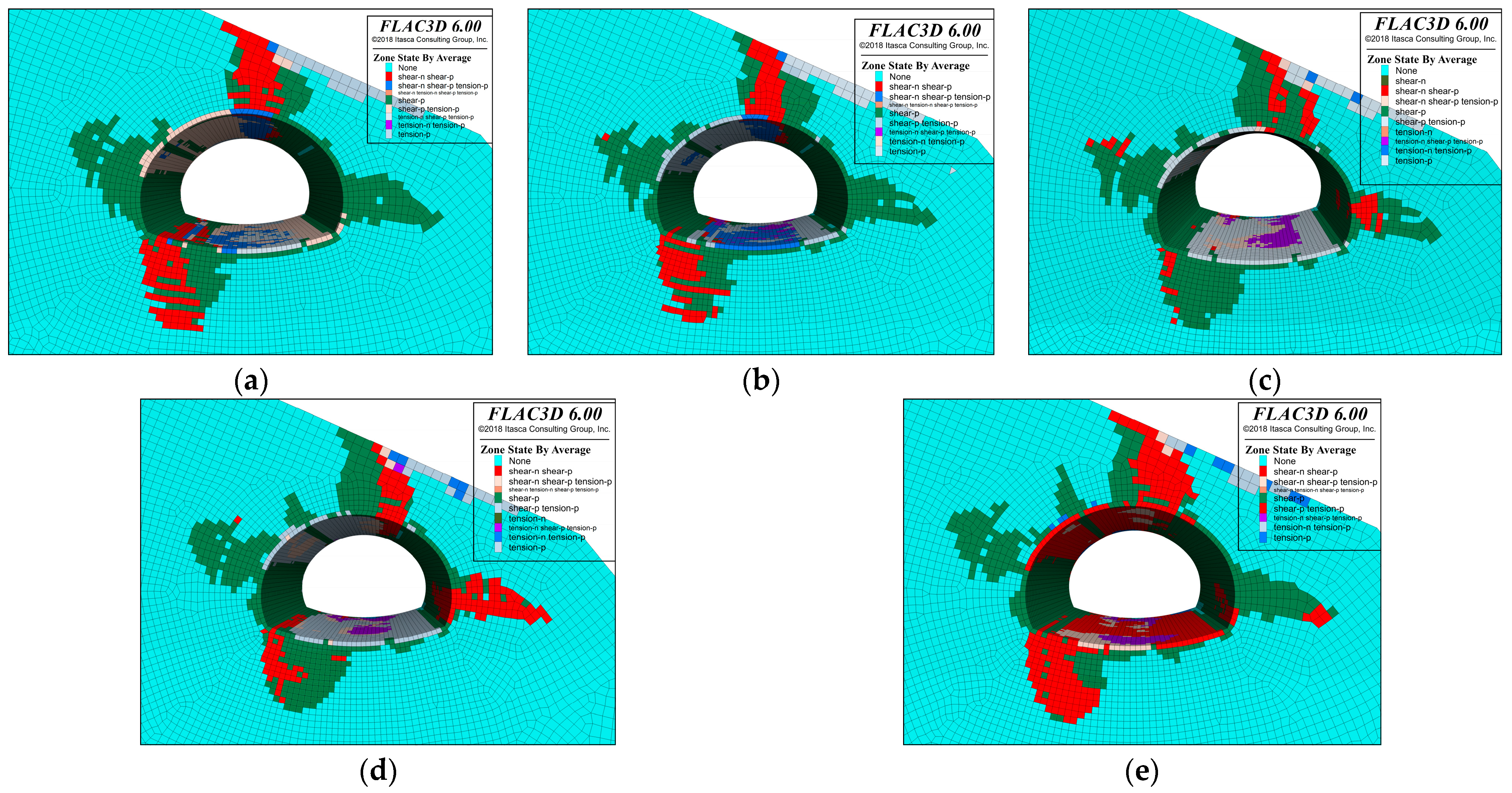
| Strata | Saturated Uniaxial Compressive Rock Strength Rc/MPa | Longitudinal Wave Velocity Ratio |
|---|---|---|
| Strongly weathered gneiss | 2.9~5.0 | 0.14 |
| Moderate weathered gneiss | 11.35~55.28 | 0.42 |
| Slightly weathered gneiss | 70.3~122.5 | 0.85 |
| Strongly weathered granite | 2.7~14.8 | 0.12 |
| Moderate weathered granite | 48.6~56.7 | 0.39 |
| Slightly weathered granite | 84.1~150.3 | 0.65 |
| Position | Maximum Value/mm | Average/mm |
|---|---|---|
| Middle drift arch (0) | 46.4~54.5 | 51.0 |
| Left drift arch (1) | 76.7~107.0 | 87.0 |
| Right drift arch (2) | 19.0~5.97 | 40.7 |
| Position | Maximum Value/mm | Average/mm |
|---|---|---|
| Left drift arch hance (3–3′) | 29.4~89.0 | 63.2 |
| Left drift arch feet (5–5′) | 33.5~108.8 | 75.2 |
| Middle drift arch hance (4–4′) | 15.4~30.2 | 20.1 |
| Middle drift arch feet (6–6′) | 23.6~47.0 | 29.3 |
| Main section arch hance (3–4) | −6.5~−8.4 | −7.3 |
| Main section arch feet (5–6) | −7.9~−15.2 | −10.1 |
| Material | Gravity/kN∙m−3 | Elasticity Modulus/GPa | Poisson’s Ratio | Cohesive/kN∙m−2 | Friction Angle/° |
|---|---|---|---|---|---|
| Surrounding rock [34] | 20.0 | 1.0 | 0.38 | 125 | 23.0 |
| Reinforcement area [34] | 20.0 | 1.0 | 0.38 | 150 | 27.6 |
| Material | Gravity/kN∙m−3 | Elasticity Modulus/GPa | Poisson’s Ratio | Thickness/cm |
|---|---|---|---|---|
| Initial support | 24.0 | 33.8 | 0.22 | 26 |
| Middle diaphragm | 23.7 | 32.6 | 0.22 | 22 |
| Bolt | 78.5 | 200.0 | 0.25 | |
| Feet-lock bolt | 78.5 | 200.0 | 0.25 |
Disclaimer/Publisher’s Note: The statements, opinions and data contained in all publications are solely those of the individual author(s) and contributor(s) and not of MDPI and/or the editor(s). MDPI and/or the editor(s) disclaim responsibility for any injury to people or property resulting from any ideas, methods, instructions or products referred to in the content. |
© 2024 by the authors. Licensee MDPI, Basel, Switzerland. This article is an open access article distributed under the terms and conditions of the Creative Commons Attribution (CC BY) license (https://creativecommons.org/licenses/by/4.0/).
Share and Cite
Wan, L.; Luo, Y.; Zhang, C.; Tian, C.; Shao, X.; Liu, Z. Study on Field Test of Deformation and Stability Control Technology for Shallow Unsymmetrical Loading Section of Super-Large-Span Tunnel Portal. Appl. Sci. 2024, 14, 5796. https://doi.org/10.3390/app14135796
Wan L, Luo Y, Zhang C, Tian C, Shao X, Liu Z. Study on Field Test of Deformation and Stability Control Technology for Shallow Unsymmetrical Loading Section of Super-Large-Span Tunnel Portal. Applied Sciences. 2024; 14(13):5796. https://doi.org/10.3390/app14135796
Chicago/Turabian StyleWan, Li, Yanbin Luo, Changan Zhang, Chaopeng Tian, Xing Shao, and Zhen Liu. 2024. "Study on Field Test of Deformation and Stability Control Technology for Shallow Unsymmetrical Loading Section of Super-Large-Span Tunnel Portal" Applied Sciences 14, no. 13: 5796. https://doi.org/10.3390/app14135796
APA StyleWan, L., Luo, Y., Zhang, C., Tian, C., Shao, X., & Liu, Z. (2024). Study on Field Test of Deformation and Stability Control Technology for Shallow Unsymmetrical Loading Section of Super-Large-Span Tunnel Portal. Applied Sciences, 14(13), 5796. https://doi.org/10.3390/app14135796





